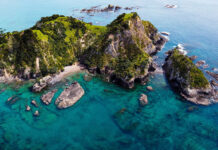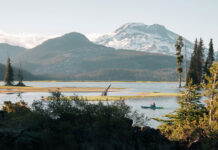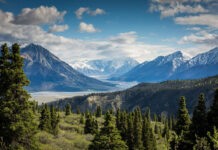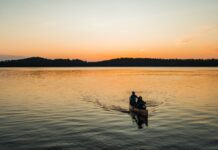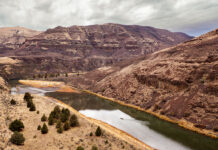In Canada’s Northwest Territories, arctic winds blow in temperatures below –40°C much of the year. But as the seasons change, the sun’s heat awakens a sleeping giant. The Slave River roars to life and flows with ten times the volume of the Colorado and four times that of the Fraser. Three thousand five hundred cubic metres of water per second travel from the prairies to the Arctic Ocean.
As the river crosses the Alberta-NWT border, it plummets off the Canadian Shield’s red granite shelf, some of the oldest and hardest rock on the planet. It passes through a sieve of islands sculpted by water and time to produce hundreds of good, bad and ugly river features. The result is one of the world’s most awe-inspiring labyrinths of whitewater—a series of rapids 30 kilometres long—a 60-square-kilometre big-water playground lit 24 hours a day by the arctic summer sun.
Extended hot days on the river are combined with never-ending golden sunsets, no McDonald’s for hundreds of miles, no cell phone towers, no distractions of globalization, and, until recently, no other kayakers in the eddy waiting for their turn on the wave.
The Slave River: Paddling the northern jewel
Every summer or two for nearly a decade, I have made the 16-hour drive from Edmonton to the “end of the road” town of Fort Smith to kayak the Slave. When I first started coming here, you could paddle for two weeks and not see another paddler. Now, there are a few locals and maybe 50 to 75 visiting paddlers a year. This may not seem like much, but it’s a major increase for a river north of 60, a testament to the growing attention the Slave is getting in the whitewater kayaking world in the past couple of years. A few years ago, kayakers described huge waves and crashing holes as “Zambezi-sized.” Today, many big-water play-boaters refer to the best waves as “Slave-like.” Whitewater kayakers from around the world have heard stories about the Slave’s enormous features and have started to make their way north.

Descriptions of “holes that would cartwheel a Greyhound bus” and “waves 30 feet high” are actually quite true. But these stories definitely do not speak for all of the features on this river. There are many smaller holes and waves dispersed throughout these rapids that can be safely paddled providing you have respect for the size of the river.
The river is channeled through a 300-meter-wide chute into a real wave train—waves the size of boxcars.
Bays filling up and then overflowing downriver create surging and cycling water levels. Pulsating like a river in flood, the water expands, folds, and erupts because of the enormous volume trying to squeeze into the path of least resistance. “Elevators” (huge eddies that provide a way to paddle upstream and work your way across the river) can be the size of football fields and have two-foot standing waves in the opposite direction to the main flow. The volume creates pressure waves and whirlpools of dramatic proportions.
Float bags are essential. Volume is the name of the game and losing your boat is more than an expensive experience. Mostly, floatbags are helpful when you’re hanging onto your boat as you get sucked into the darkness of a giant whirlpool, which can reach 30 feet deep and are as dangerous as their tornado counterparts.
Paddling with a group is another must. This river is three kilometres wide in places. If you lose track of someone, they’re basically on their own. It’s very difficult to see swimmers in the silty brown water amid the numerous channels and holes.
Visiting paddlers should be armed with good knowledge of the features and lines. The only way to do this is to find a local guide or someone with previous Slave experience.
A final word of advice: Be prepared with a bug jacket in your boat or end up possibly overdosing on bug repellent.
Paddling the Slave River
The Hudson’s Bay Company and Northwest Company set up fur trading posts at either end of the Slave’s rapids. Fort Fitzgerald, at the top of the rapids, is all but abandoned today. Fort Smith, overlooking the last set of rapids, marks the site where river boats once reloaded after the long portage. Now, Fort Smith is the NWT’s government, education, and whitewater center.
The local population is very friendly, the mood is relaxed, and you can find all the necessary amenities—a pool with hot showers, a movie theater, and a couple of watering holes to quench your thirst. Each of the Slave’s four main rapids—Cassette, Pelican, Mountain and Rapids of the Drowned—has its own put-in and take-out along the road from Fort Smith to Fort Fitzgerald. Since the rapids are a few kilometres long followed by lengthy portions of flatwater, each one is a separate day trip out of Fort Smith.
1 Cassette Rapids: Land of a thousand holes
At the put-in for Cassette, the first rapid, you’ll recognize the dock where old paddle-boats used to end their long journey down the river’s lake-like upper reaches. Named after a trading company’s money cassette lost on a misguided run through the rapids, this set is the most difficult to navigate. Here, the river is three kilometres wide with many islands breaking up its course. Ferrying across to the opposite side can take up to 45 minutes.
Cassette is special for its amazing surf. Waves named Outrageous and Rollercoaster offer big, fast, bouncy rides if it’s ideal water level and you know where to look. Along with the big waves goes an expansive area known as Land of a Thousand Holes that you must cross on your way to the take-out. This run is a full day affair.
2 Pelican Rapids: Prepare to be ragdolled
The second set of rapids is notably larger and more dangerous than Cassette. Most of the river is channeled through a 300-metre-wide chute into a real wave train—that is, the waves are actually the size of boxcars. On either side of the main flow are enormous holes with eddylines and whirlpools to match. The power of the virtual lake raging through the main channel creates a gut-wrenching roar that will awaken any sub-conscious fears. On calm days, a rising mist makes the hairs on your neck stand at attention.
Although Pelican doesn’t require significant paddling skills to line up, this is definitely an advanced section, requiring comfort with house-sized waves dumping on your head and an ability to remain calm as the river ragdolls you without warning.
In 1998 my partners and I finally worked up enough nerve to tackle the main flow and I ended up with the first surf of Pelican. We each took turns pulling out of the pulsating eddy, across a smaller wave train and down the highway-like ramp. At the bottom of the long, sloping, runway, we met the first wave; a 30-foot cycling monster followed the gigantic wave train. With the surging water levels, the Pelican wave changes shape every 30 seconds or so from a crashing wave to a rolling hump.
My first surf was made possible by lucky timing. I floated toward the awaiting ramp, turned my boat around to face upstream, and, with my stomach in my throat, climbed the face just as it broke behind me like a perfect storm.
Now, we run Pelican in pairs to aid rescue situations. The time it takes to break into the main flow from the eddies below makes it impossible to get to a swimmer in time, if you can even find them. A swimmer with a wingman can get to one of the closest islands—two kilometres downriver—that much sooner.
One of our group members tested this theory inadvertently. His spray deck imploded when a wave crashed down on him. He swam out of the notorious river left hole, down the boiling and folding eddy line, and into a giant whirlpool, only able to look up to the unreachable cone of air. Resurfacing was followed by repetitive breathless periods of underwater, unsynchronized swimming. After finally being towed by his rescuer to one of the small islands, he violently ejected river water from his stomach and lungs, along with any illusions he’d had about the mercy of the river.
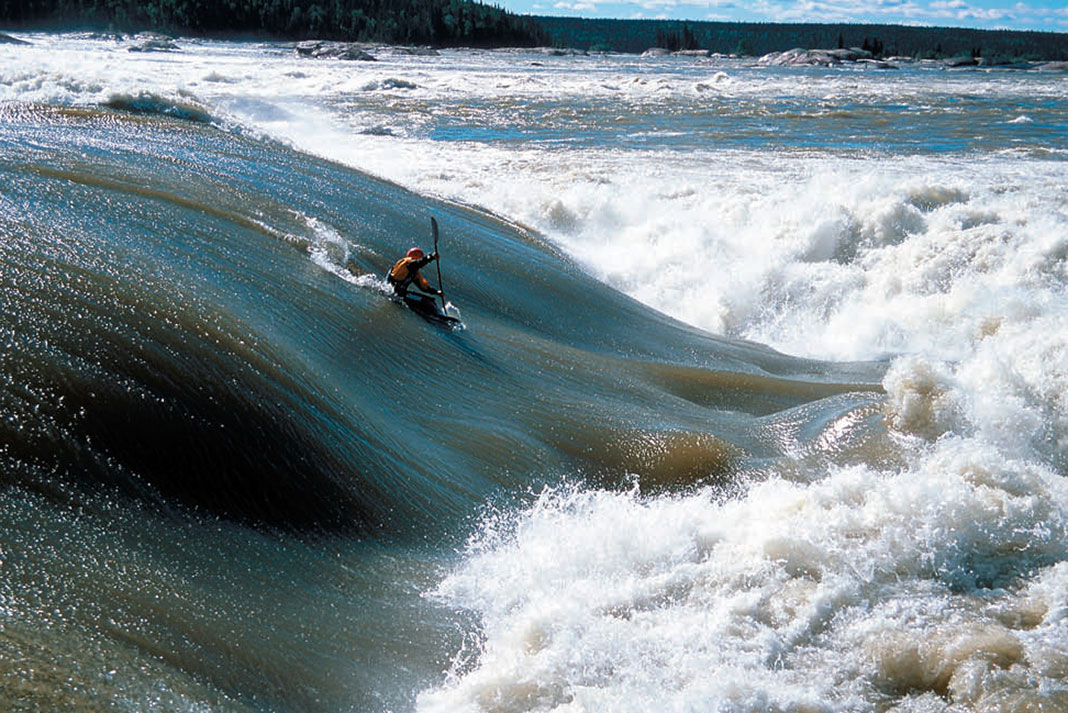
3 Mountain Rapids: Butterscotch Nipple
With Pelican being the most intimidating rapid, the next, Mountain, is one of the most welcoming. It has many surf waves and holes for paddlers of all abilities. The Slave bends around a peninsula and over a series of ledges and shelves. The rapids are named after Mountain Portage, an arduous trek up and over the 150-foot-high trail to the other side of the peninsula. The portage was once used to transport supplies around the rapids, but today kayakers use it as an easy way to paddle this section without a shuttle.
These are the rapids that should have been named Pelican. A large colony of the birds breed on the islands in the middle of the rapid. These islands are a wildlife sanctuary and must be avoided. The area is even a no-fly zone because helicopters were disturbing the pelicans.
These monsters are Slave-sized servings of pounding recirculating holes.
One of the possible routes through Mountain takes us to Molly’s Nipple, a mesmerizing drop that, at the ideal water level, forms a rounded, gently curved ramp into a large, horseshoe-shaped recirculation. The silty water rippling over the underlying sculpted rock takes on the texture of hot butterscotch toffee.
For the wild at heart, Fury and the Edge are super-sized servings of pounding recirculating holes. These monsters will consent to the biggest of aerial maneuvers and dole out the largest of thrashings. Various big-name American kayakers have swum out of the Edge.
The intermediate run on this section usually begins with Turnpike, followed by Avalanche, and finishes with Playground, a really exciting and challenging day for a first big-water run. Playground, which can be accessed directly by the takeout, is as good as it gets for beginner rodeo stars. Next to a sandy-beached bay lies an outcropping of rocks, creating a fabulous BBQ site and a great rodeo hole conspicuously named Spanky.
4 Rapids of the Drowned: Pay your respects
Last before Fort Smith are Rapids of the Drowned. Here, the Fort Smith paddling club hosted the 1994 Canadian Whitewater Slalom Championships. The racecourse was erected around a channel between three or four connected islands. Spectators were shuttled by motorboat to the islands where kayakers raced through gates between the large granite outcroppings.
The rapids are seldom visited by kayakers due to the lengthy paddle out to the playing features. But it’s worth driving to the take-out, to spend an afternoon on the rocks, watching the pelicans feed and looking for black bears foraging on berry bushes along the bank. Or, to truly appreciate these rapids, take a walk at sunset to the lookout directly across from the graveyard. Here, the sepulchral mood is often enhanced by the dark blackened eyes and curiously tilted heads of the ravens perched upon the wooden crosses of the buried rivermen who came before.
Shawn Grono has kayaked rivers in New Zealand, Chile, Ecuador, the U.S. and Canada and made the first descent of Molly’s Nipple on the Slave. He is an Alberta Whitewater Association Kayaking and River Rescue Instructor and maker of whitewater adventure films including the documentary Slave to the River.
Ten Colorado Rivers plus a 300-meter-wide channel equals boxcar-sized waves and 30-foot-deep whirlpools at Pelican Rapid. | Feature photo: Ryan Creary




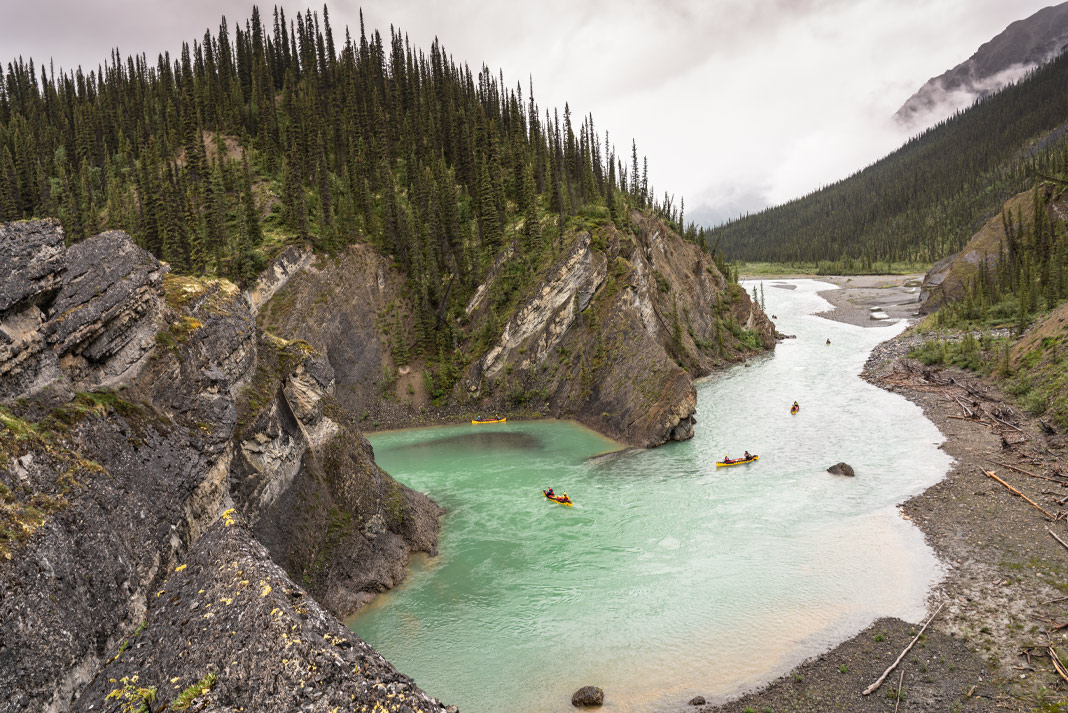
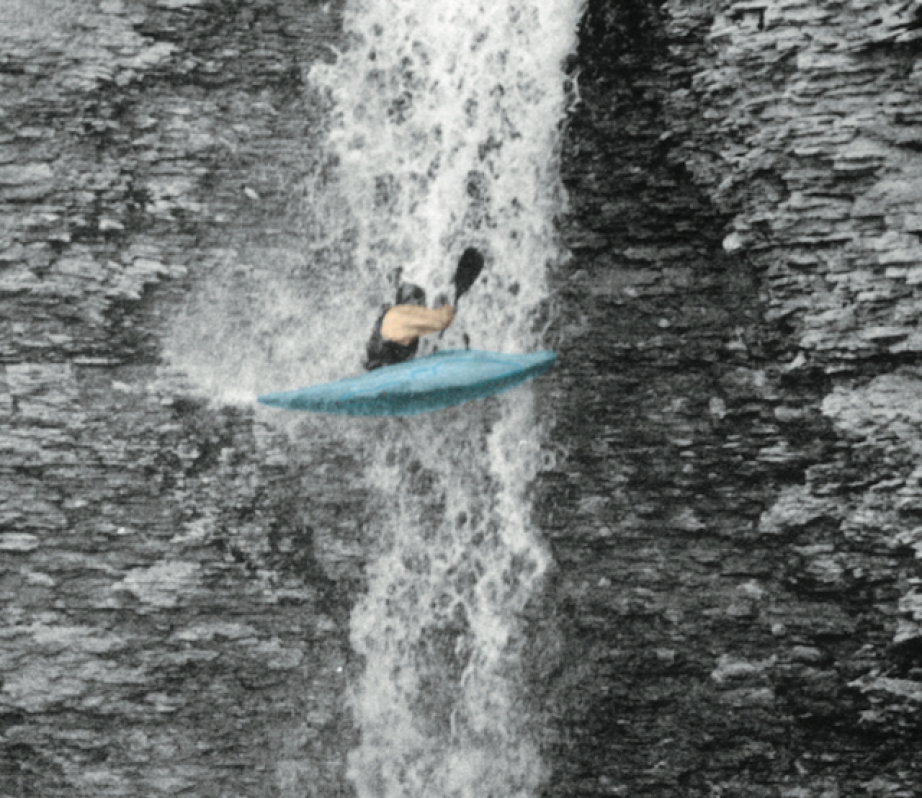
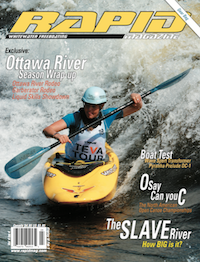 This article was first published in the Winter 2002 issue of Rapid Magazine.
This article was first published in the Winter 2002 issue of Rapid Magazine. 